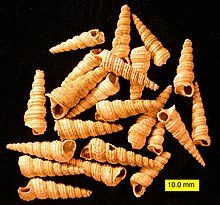Turritella
|
Turritella Temporal range: Cretaceous–recent |
|
|---|---|
 |
|
| Fossil shells of Turritella cingulifera from the Pliocene of Cyprus | |
| Scientific classification | |
| Kingdom: | Animalia |
| Phylum: | Mollusca |
| Class: | Gastropoda |
| Subclass: | Caenogastropoda |
| Order: | Sorbeoconcha |
| Superfamily: | Cerithioidea |
| Family: | Turritellidae |
| Subfamily: | Turritellinae |
| Genus: |
Turritella Lamarck, 1799 |
| Species | |
|
See text |
|
| Synonyms | |
|
|
See text
Turritella is a genus of medium-sized sea snails with an operculum, marine gastropod mollusks in the family Turritellidae.
They have tightly coiled shells, whose overall shape is basically that of an elongated cone.
The name Turritella comes from the Latin word turritus meaning "turreted" or "towered" and the diminutive suffix -ella.
Valid species within the genus Turritella are listed below. Fossil species are marked with a dagger "†".
These are species assigned to Turritella that were brought into synonymy with other taxa:
The genus is known from the Cretaceous to the Recent periods.
The shells are quite frequently found as fossils, and the carbonate stone made from large quantities of Turritella shells is often referred to as "Turritella limestone", or, if silicified, "Turritella agate". Both varieties of this stone are commonly sold as polished cabochons.
One variety of "Turritella agate", that from the Green River Formation in Wyoming, is a fossiliferous rock which does indeed contain numerous high-spired snail shells. However, contrary to the common name, these snails are not in the marine genus Turritella, instead they are freshwater snails in the species Elimia tenera, family Pleuroceridae from the Eocene epoch. The rock in which these snail shells are so abundant varies from a soft sandstone to a dense chalcedony. This dense silicified rock is popular with gem and mineral hobbyists, as well as with New Age practitioners.
...
Wikipedia
